This was published 8 years ago
Trekking in M'Goun Valley, Morocco: The treacherous path few visitors have hiked
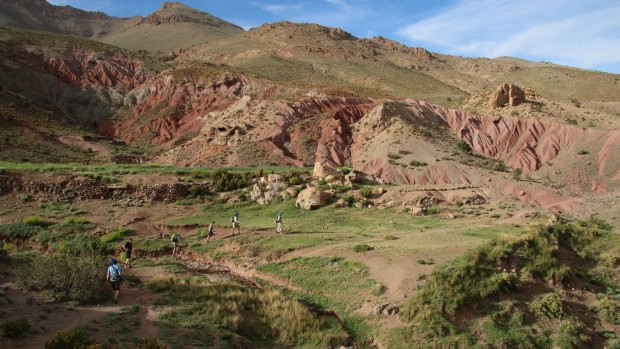
Trekkers traverse the floor of M'Goun Valley, Morocco.Credit: Richard Tulloch
The little log and stick bridge is supported by sandbags at each end. It has sagged onto the surface of the muddy river, its waters swollen by melting snow from the surrounding peaks. It has no handrail.
Local children skip over its 15-metre span. Village women stoically struggle across, carrying absurdly large bundles of animal fodder on their backs.
Nobody seems to have any trouble. Until it's our turn: six Dutch hiking friends, one Australian and our Berber guide Khalid, two hours into our five-day trek through the foothills of Morocco's High Atlas range. Our cook and three mules with their drivers have gone on ahead, carrying our tents, cooking gear, sleeping bags and spare clothes.
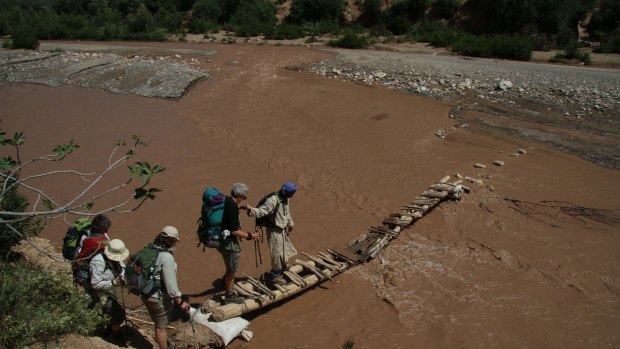
Crossing flooded rivers in the M'Goun Valley, Morocco, can be hazardous.Credit: Richard Tulloch
Water splashes over the bridge, making the wood treacherously slippery. Things happen fast. Two members of our party topple into the river, closely followed by guide Khalid, who loses his footing as he turns back to help.
It takes a few anxious minutes for us to steady ourselves and haul them to safety, before tottering to the opposite bank.
One of our friends has sustained an ugly gash on her leg and stitches will be needed.
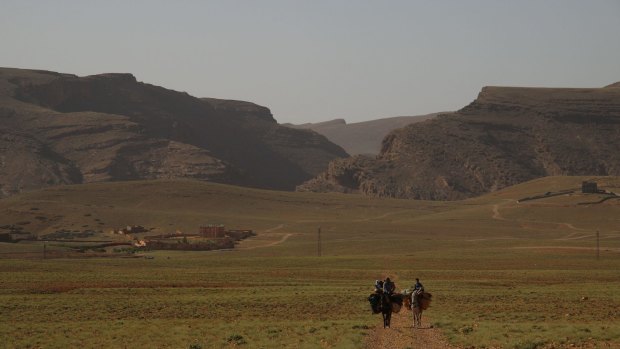
Donkey carry trekkers' luggage through Morocco's M'Goun Valley.Credit: Richard Tulloch
We're getting an instant lesson in the challenges of hiking in an area that sees few visitors.
Khalid dries out his mobile and makes a call. A gentleman on a mule appears up the river. It's the ambulance service. The patient is ferried to a road, where a vehicle arrives to take her to a doctor. Our guides promise to keep us in touch with her over the next few days while we continue our adventure.
And an adventure it certainly is.
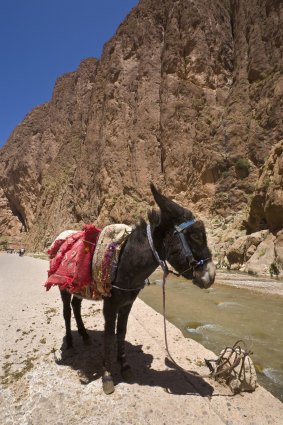
A donkey waits patiently in the Todra Gorge.Credit: Paul Thompson
Here in the M'Goun Valley, visitors can be numbered in the hundreds. In the height of the trekking season, we briefly cross paths with only two other groups and most days we meet none.
Yet it's an extraordinary landscape, in its way as spectacular as anything I've ever seen.
The Vallee des Roses (Valley of the Roses) is in full spring bloom. Everything is flourishing: almonds, walnut trees, olives and pomegranates. Wheat fields are separated by rose hedges. Birdsong is all around us.
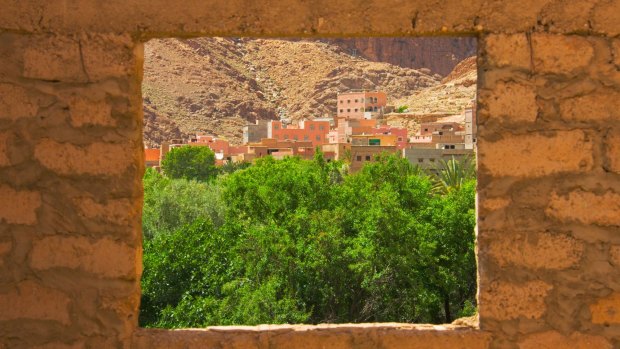
An old casbah in Todra Gorge.Credit: Alamy
We climb cols more than 2500 metres high, emerging to vistas of cliffs and canyons and snow-speckled mountain peaks. Below us, ochre mud house villages are camouflaged against the hills. Patches of brilliant green indicate where water has brought the desert to life.
In Agouti Gorge we change our boots for sandals to wade a few kilometres through the cool water of the Talkadit River, with towering sandstone cliffs above.
The mules add to the experience. They carry the heavy stuff, leaving us only water and cameras to tote in our daypacks. We love watching them being loaded up in the mornings, overtaking us along the track (they travel surprisingly fast and are apparently tireless) and finally waiting patiently at our campsites.
The route we're trekking is rough and there are no signposts, so Khalid's guiding is essential. Walking days are long, normally seven to eight hours, and we sometimes climb and descend several hundred metres over rocky terrain. But the hiking is not overly demanding, even for those of us on the wrong side of 60.
Khalid keeps the pace manageable, with plenty of short stops for water. We take long lunch breaks in the heat of the day, usually by a river under shady trees. Most Berber villagers we meet ignore us. The Romans called them "barbari", from which we derived "barbarian". A few return our smiles, waves and greetings, though many do not. They possibly think we're crazy for being here, in a harsh region where few would live if they had a choice.
Herders watch suspiciously as we pass, as if making sure we intruders leave the premises without nicking any goats.
Amazigh (Berber) villages appear primitive. Clusters of mud huts with tiny windows are enclosed behind high walls, surrounding the tall square tower of the village mosque. Some herding families still live in caves in the hillsides.
We learn just a few polite words of Berber language; the lingua franca of Morocco is French, which luckily I studied at high school.
After dinner, our guides lead the entertainment, with hand drums, singing and, on one clumsy occasion, dancing.
Some nights we pitch tents, though the spring weather is so mild we hardly need them.
When we put up for one night in a Berber family's farmhouse, sleeping on mattresses lined up on the bare earth floor, I'm delegated to ask Khalid the delicate question about toilet arrangements. The answer is a laugh and a broad sweep of the arm. There's a lot of desert out there.
Cook Youssef and his team prepare wonderful food. Lunches are salads of tomatoes, cucumber, corn, olives and smoked fish; dinner usually tagines of couscous, potatoes, rice, vegetables and chicken. This being strict Muslim territory, there is no alcohol. We call it our "Betty Ford Clinic – M'Goun Branch."
After five days on the track our clothes are dusty, our bodies are tougher, our French has improved, our camera batteries are low and everything tastes slightly gritty. We're ready for a beer, a bath and a toilet with a seat.
Magically, in the next village a vehicle is waiting to take us to guesthouse Kasbah Itran. Our injured friend has been well cared for there and is on the road to recovery.
Some day this gorgeous part of the world may see thousands of tourists pouring from buses. There'll be quad-bike and camel rides and hassling hawkers selling souvenirs. Every bridge will have a handrail.
I hope that day is a long time coming.
TRIP NOTES
GETTING THERE
Emirates flies return Sydney/Melbourne to Marrakech via Dubai and Casablanca. See www.travel.com.au
Bus from Marrakech to Kasbah Itran via Ouarzazate takes about 6 hours. A private shuttle can be arranged by Kasbah Itran.
SEE + DO
Kasbah Itran guesthouse offers eight-day Amazigh Villages adventures, including transfers from Marrakech, 4-5 days trekking, accommodation (guesthouse, tents), guides and all meals from $520 per person for groups or $865 for two people. See www.kasbahitran.com. The trek is offered year round. However, best times are spring (March-May) or autumn (September-October) avoiding the worst summer heat and winter freeze.
FIVE OTHER MOROCCAN ADVENTURES
1. Hammam A visit to a steamy Moroccan bathhouse is a not-to-be-missed experience, especially after a dusty, smelly hike. BYO towel!
2. Ouarzazate film studios. The studios where Gladiator, The Jewel of the Nile and more recently Game of Thrones were filmed are about an hour's drive from the Valley of the Roses. Short tours cost EUR4. See studioatlas.com
3. Ourika Valley. The mountains, riverside restaurants and Setti Fatma waterfalls 90 minutes from Marrakech make it a popular escape from the city. Tours available from Marrakech tourist offices.
4. Marrakech. Touristy, sure, but it's still an exciting, exotic city, with extraordinary markets and gorgeous gardens.
5. The 5-hour drive from Marrakech to Ouarzazate is an adventure in itself, passing over the cols of the High Atlas range. Book travel in any Marrakech tourist office.
The writer travelled at his own expense.
Sign up for the Traveller Deals newsletter
Get exclusive travel deals delivered straight to your inbox. Sign up now.